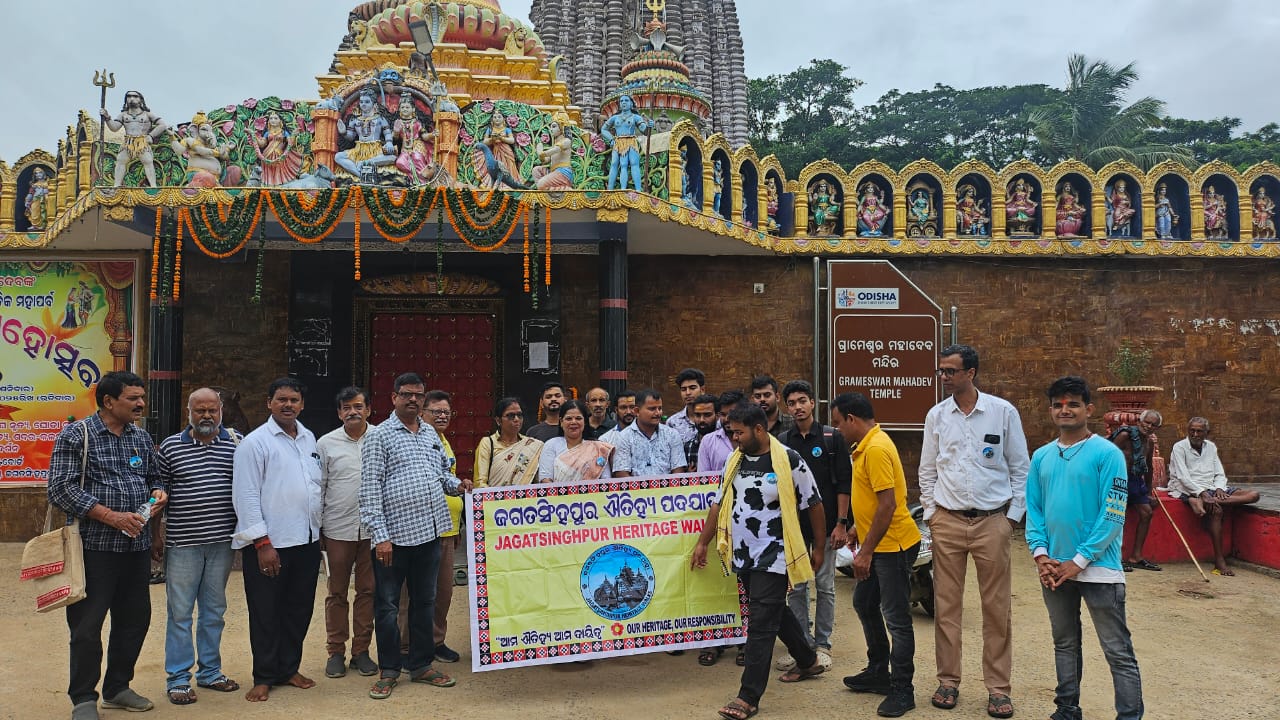Jagatsinghpur: The 6th edition of the Jagatsinghpur Heritage Walks (JHW) yesterday captivated some 40 participants from across Odisha as it delved into the rich history and spiritual significance of the ancient Grameswar Temple in Panchapalli village. This evocative village, whose name “Panchapalli” signifies five hamlets – Gobindapur, Patana, Paniendula, Naradia, and Tikarapara – is imbued with a deep religious sanctity, reinforced by the reverence for five village goddesses representing these constituent areas.
The focal point of the walk, Shree Grameswar Mahadev’s abode, stands majestically on the banks of the Hansua river. This revered site boasts a mention in Vedic texts, notably as “Garga Peetha,” hinting at its profound antiquity. The origin story of Shree Grameswar Mahadev is a fascinating blend of mythology and local folklore.
Legend recounts that a ruler of Bishunpur, intrigued by a cowboy’s tale of a cow regularly oozing milk at a specific spot, ordered an excavation. To their astonishment, a “lingam” of Lord Mahadev emerged from the earth. The king, despite his efforts, could not ascertain its depth. As the lingam appeared in the heart of the village (grama), the king aptly named it “Grameswar Mahadev.” Following its emergence, the king commissioned a humble wooden and thatched shrine and brought in Brahmins from Kanyakubja to perform pujas and rituals for Lord Shiva.
An alternative narrative from Puranic texts posits that the revered Sage Garga, son of Lord Brahma, originally installed this lingam for worship. After Sage Garga’s demise, the lingam was buried, only to be rediscovered through the unusual phenomenon of the cow’s milk. This Puranic link is why the site is also known as “Garga Peetha,” a fact further substantiated by a small temple dedicated to Sage Garga on the Grameswar Mahadev premises.
Following the passing of the Bishunpur king, local landlords took on the sacred responsibility of worshiping Lord Shiva. Over time, the Endowment Commission stepped in, forming a trust to manage the temple. The original wooden and thatched structure eventually gave way to a magnificent new temple, soaring to a height of 71 feet, constructed with the active support of the trust and local villagers.
Today, the exquisite sculptures adorning the walls of Shree Grameswar Mahadev and the vibrant festivals celebrated here continue to draw devotees from across Odisha and beyond. Beyond Lord Shiva, the temple complex also houses the Nrusinghnath temple, where Lord Jagannath, Balabhadra, and Subhadra are also worshipped, further enhancing its spiritual allure.
The heritage enthusiasts’ journey extended beyond the temple, with a visit to a 100-year-old primary school that recently celebrated its centenary. Headmistress Laxmipriya Swain and retired headmaster Shuva Narayan Nayak warmly welcomed the group. Dipak Samantarai, Convenor of Cuttack Heritage Walks, addressed the children, emphasizing the importance of heritage conservation. Pravanshu Samantaray of Dibyaduta publication also interacted with the students and distributed Odia story books. Biswaranjan Dehury of Odisha Heritage Walks extended a vote of thanks to the villagers and participants for their enthusiastic involvement.
Earlier in the day, at the Grameswar Temple, JHW convener Srikanta Singh extended a warm welcome to the temple trust committee and villagers, who were led by Sishir Kumar Biswal and Jivananda Mishra of Vidyapuri Publication, setting a collaborative tone for this enriching exploration of Jagatsinghpur’s enduring heritage.


